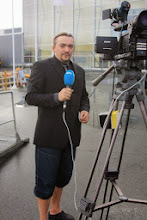I dag ringte de fra Sveitsisk tv, og ville kjøpe reportasjen jeg lagde i sommer om stencil-art kunsten i Lofoten. Har skrevet på litt hastig engelsk den reportasjen som vi publiserte på nettet i Norge, og tenkte bare å poste den her i Bloggen. Skal også legge opp noen flere bilder av det DOLK og PØBEL har laga. Men så langt; her er saken på engelsk:
_______________________________________________________________________________
Urban street art in the middle of nowhere
Two Street artists, five houses, indefinite pints of paint – this is only some of the gear in need for making urban art at the countryside.
By John Inge Johansen, journalist NRK
If you’ve ever walked in the streets of London, Oslo, Lisabon or Bergen, you might stumbeled across some extremely detailed prints on the walls. Stencil art is the name of the game, and it breeds as a step-brother of tagging and grafitti. It is an underground movement, and two of the most reknown and experienced artists of Norway has now gone loose on Lofoten Walls.
The archipelago of Lofoten is one of the most visited places in Norway, but in spite of the many tourists visiting during summer, a lot of places has been deserted. Houses has been left to themselves and the forces of nature has tempered the canvas for the young artists.
Dolk & Pøbel
As a rule, none of the ”pieces” in Lofoten are signed by the artists. The experience of stumbling into an artwork is supposed to be there for the viewer and the wall.
“Dolk (in english: Dagger)” is from Bergen and he states that:
- There are always so many faces and names standing in the way of the spectator. It has influence on your own comprehension of the motive, he says to Norwegian television. We would like people to reflect and think for themselves, regardless of the name of the artist.
Dolk is a signatur in the street art-society, he has gained an international reputation. Recently some of his prints were sold for 200.000 NOK (equals 20.000 GPB) during only a few days. He has been on tour at several artfestivals – and in Lofoten he cooperates with the signature “Pøbel”
Ghetto Spedalsk
The object of their project is to move the urban expression out in the middle of nowhere. They spraypaint their pieces on deserted houses – at the size of a whole wall. Some houses has even been visited on the inside. What differs from life in the city, is that in Lofoten all pieces are made with permission of the owner of the premises. And they are surprised over the quickness that the Lofoten people has adapted their style.
- When we ask the owners of the houses, it seems like they have been reading the local newspaper or seen what we have done at houses nearby the mainroad. Then they invite us to spend the night at their place, and give us the opportunity to work by ourselves for hours. This is another world compared to what we do in the cities, Pøbel says to Norwegian television.
Their new project is named”Ghetto Spedalsk (Ghetto Leprachaun)”
- We are going to decorate all of the twenty-something houses that we have owners permission to work with. During the summer of 2009 we will have an international stencil art festival in Lofoten – all anonymously and unannounced. Then our street art will be discovered after we leave the islands. That is something we really look forward to do, says Dolk.
NRK Nordland, the regional part of Norwegian Broadcasting went on a guided tour along the works in Lofoten. This is highly unusual, none of the two has ever given an interview with a live camera present. The danger of beeing recognized is too high, and since most of the stencil art in urban areas are made illegaly, they will not take the risk.
Proud head of cultural office
As for the muncipality of Vestvågøy, the art in itself represents an enormous gift. “The sleepwaker” was originally made at a fitness-center in Bergen. Rumours says that the owners paid 10.000 GBP for this pice of work. It is impossible to estimate the complete value of the work made in Lofoten. Head of the cultural office in the muncipal administration, Camilla Skadeberg is proud of the project, hence not the economical part of it:
-What they do, is putting attention to deserted houses in a completely new way. Maybe the spectators will have another view of houses and real estate in Lofoten when they discover the paintings. This twists the value of a deserted place from being worthless to a genuine piece of art – and this might start mental processes for the viewer. I like it, she says to NRK.
Wednesday, October 29, 2008
Subscribe to:
Posts (Atom)
